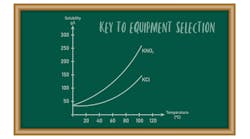Powder/Fluid Handling: Don’t Stint On Separator Selection
You’ve made your slurry or paste from crystallization. Now, the next hurdle is separating the desired product from the mixture. Often, we focus on the particles but the product also could be the liquid. What separation device should you use? Here, a chemist may provide some insights, as I counseled in my column “Talk to a Chemist,” by investigating alternatives to the process design by looking at other physical properties that might suggest different separation options. However, laboratory results rarely enable easy and direct scale-up to industrial-size equipment.
We may need more data, such as settling characteristics, cohesiveness of the solids, detailed filtration rate (filter or G-force), and desired quality of the product (either liquid or particulate solid), as I outlined in my column “Should You Use a Filter or Centrifuge?” It would be a shame to waste all the energy that went into making these crystals. Equipment for solid/liquid separation often is the most inexpensive part of a process and, thus, frequently gets the least amount of time devoted to its selection. However, inadequate attention can lead to a costly mistake.
The two columns I’ve cited address the question of how you should go about selecting a filter or centrifuge but not why. I did hint you must consider the human factor (the operators); however, that’s a political problem. In this column, let’s look at some of the technical factors involved in the choice: cost, process complexity, and the next step in the production sequence.
Cost sounds simple but involves issues that often get downplayed or ignored. It must include labor, environmental impact, lost production due to upsets, and reliability. If you select a filter or a filtering centrifuge, what do you do with the worn-out cloths or media? Are they hazardous? Are spills possible and how would you handle them? Remember that removing solvent in a filter or centrifuge is much cheaper than passing the material to a dryer. This can justify more-complex and -costly equipment for the separation step.
Process complexity can be an advantage or a problem. One of the biggest mistakes I’ve seen in solid/liquid separation is trying to accomplish the task in a single piece of equipment to keep things simple. We had a peeler centrifuge that occasionally overflowed when it would get a batch of heavily loaded solids. Normally, the loading to the centrifuge was low and the timed feed worked fine. However, piping layouts allowed for settling at low production times. The solution was to add a hydrocyclone to make the feed to the centrifuge more uniform. A secondary advantage of adding this inexpensive device was to increase utilization of the centrifuge.
Solid/liquid separation is unique compared to other technologies because the form of the material leaving the step can significantly impact downstream equipment’s operational and capital cost. Centrifuges prefer high solids loading, while filters are more forgiving. When the product is the solvent, then filters are the best choice. However, you often need secondary filtration to reach product quality requirements. Most solid/liquid separations yield a paste or cake that would go to a dryer in the form of clumps. However, these clumps frequently require dispersion to improve drying and flowability. An alternative is the use of extrusion. This not only removes the solvent mechanically but also heating of the solids can dry the product to produce pellets or ribbons.
One of the challenges faced in solid/liquid separation is handling the slurry from the crystallizer as well as the wet cake from the separation. Intermediate storage of slurries is fairly straightforward but is not without problems. A classic example is feeding a centrifuge with a wide particle-size distribution. We had a batch operation where the centrifuge feed tank relied on an impeller to keep the solids suspended during production of batches of wet cake. As the feed tank was drawn down, the time needed to make a wet cake batch increased and the product became finer. While the impeller kept the solids suspended, it only mixed the lower part of the feed tank. The solution: recirculate slurry to the top of the tank with the centrifuge feed pump.
My next topic is drying the wet solids.


